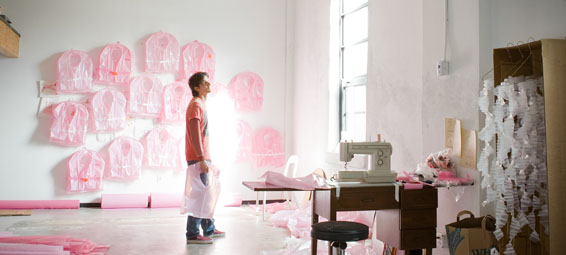In the fall of 2009, SMU inaugurated the Meadows Prize, sponsored by the Meadows School and the Meadows Foundation and selected by a committee of 12 international arts professionals. These awards were given to individuals or groups that “share the Meadows School’s commitment to creating art or scholarship that has had a transformative impact on both local and global society.” Creative Time, a New York-based organization that has commissioned and produced works of public art that are experimental and socially engaged since 1974, was awarded the prize and began a series of research trips to learn about the cultural landscape of Dallas and the wider metropolitan area and to propose a project that would be sensitive to its site specificity and leave a cultural legacy to the city. On these trips Creative Time met with artists, curators, collectors, educators, writers, civic leaders, and architects to learn about the urban fabric of a city that, through the Arts District, had recently made a huge investment in the arts. This process was primarily about looking and listening, but it took part in a wider dialog that had already started in Dallas about building and maintaining a viable and sustainable artistic community.
Following the financial crisis in 2008, a number of galleries in Dallas began to close. Christina Rees, who used to run Road Agent Gallery and now is the director of Fort Worth Contemporary Arts, was one such gallerist who had decided to close her doors. She wrote a piece for Glasstire that chronicled the condition of that moment in a way that was so powerful that it began both informal and formal ripples of dialog. One such formal structure was a series of lunches organized by Rees and Thomas Feulmer, director of educational programming at the Rachofsky House, and sponsored by Howard Rachofsky. These lunches brought together artists, curators, gallerists, collectors, and writers to discuss the state of the art community in Dallas. While it is hard to say if there was something concrete that was produced by these conversations, there’s no denying that the explicit dialog across institutions and individuals embodied a spirit of collaboration and cooperation that many in Dallas had not felt in awhile.
In the wake of these lunches, a number of things happened. Just to mention two: This publication, FrontRow, was launched to provide robust coverage of the arts in Dallas, and secondly, Creative Time’s Meadows Prize built on the process of dialog begun by Rees and Feulmer.
Talking was a way for Creative Time to learn about our community, but it was also a way for us to talk to each other. For instance, in one dinner with artists I learned details about the Good/Bad art collective that I had never heard before. While Creative Time met with many people illustrating a diverse and vibrant art culture, for reasons of time and logistics, there were many not included in this process. I was one member of the committee of SMU faculty and staff that coordinated the process of Creative Time’s engagement with Dallas and can speak from experience that while we tried hard to set up meetings with as many people as possible, there were many very important voices that were unfortunately left out.
I know that some might worry that this report is a judgment from outsiders. Some might say, “who is Creative Time and by extension, SMU, to tell us what to do?” My first answer to this is that neither Creative Time nor SMU is trying to tell anyone what to do. This report chronicles a number of impressions and suggestions that hopefully will reinvigorate a conversation within the Dallas community about what are our priorities are. The second issue is the relationship between local and national communities. Dallas will only become more of a regional outpost if it cuts itself off from national or international dialog. This is why museums bring in traveling exhibitions, local collectors buy work in New York, Los Angeles, London or Berlin, and universities invite artists, critics and curators for lectures. Granted, they are usually speaking about their own practice and not Dallas, but Creative Time tried to bring together their experiences in New York and elsewhere with those they had in Dallas.
Some might say that many of their recommendations are happening already — but how do we sustain them? Some might say that this is all talk and ask how we can move beyond rhetoric and follow it with action? The first step is to not only deliver statements but also allow for a space for response.
That begins here with this report, which will be augmented by commentary from the Dallas community. Following this report, SMU and Creative Time will host a conference called The Freedom of the City: Models of Urban Engagement & Creativity on April 9, that is about new models of public art practice and architecture in the urban environment. Timed to correspond with the Dallas Art Fair, it will include both national and local figures that will engage directly in dialog with one another and open up the conversation to feedback from a Dallas audience.
As this document states, we are on the cusp of some decisions that could have a major impact on our community. This conference will help us to think through the role that culture can play in not only the Arts District, but also The Trinity Project, the Woodall Rogers Park and neighborhoods like West Dallas that will be radically transformed by the new Margaret Hunt Hill bridge designed by Santiago Calatrava. In collaboration with D Magazine and FrontRow, the Meadows School will continue to develop complementary programming, events, and conversations in the coming months to continue the momentum of the dialogue. Speaking on behalf of the SMU committee that worked with Creative Time, I look forward to hearing feedback and responses to their work.
Photo: Artist James Gilbert at work at Centraltrak. (Credit: Joshua Martin for D Magazine)





